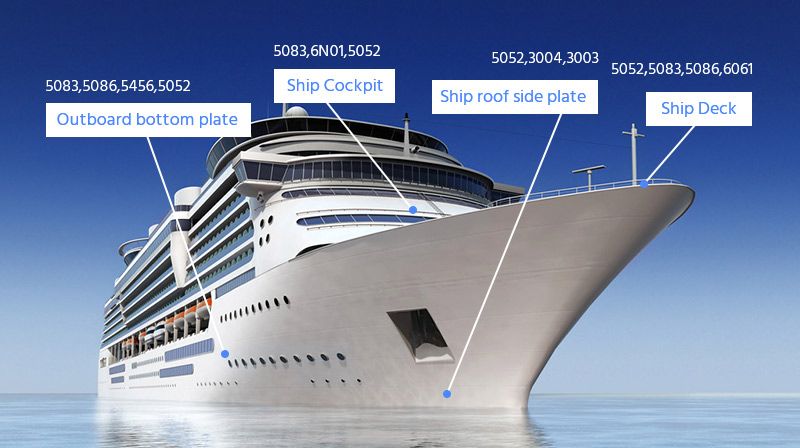5083 aluminum belongs to the Al-Mg-Mn series (5000 series) non-heat-treatable strengthened alloy. Due to the synergistic effect of magnesium (4.0%~4.9%) and manganese (0.4%~1.0%), it is naturally resistant to seawater corrosion, lightweight and high-strength. Both H116 and H321 tempers have further optimized these properties through work hardening processes and are suitable for key ship structures.

Core advantages of 5083 aluminum plate for ship building:
1. Excellent seawater corrosion resistance (the decisive advantage in shipbuilding scenarios)
- Material intrinsic corrosion resistance:
Magnesium forms a dense MgO oxide film on the surface of the aluminum matrix, isolating the erosion of the matrix by seawater (containing chloride ions), and its corrosion resistance far exceeds that of carbon steel (frequent anti-corrosion coating maintenance is required) and most aluminum alloys (such as 7 series high-strength alloys).
- Process-enhanced corrosion resistance:
H116 and H321 both use cold working or annealing processes to reduce the tendency of intergranular corrosion, which is particularly suitable for parts such as hulls, decks, and seawater pipes that are immersed in seawater for a long time.
- Case: The yacht hull in the Aegean Sea of Greece uses 5083 aluminum plates, which have no obvious rust after 15 years of service, while the carbon steel hulls in the same area need to be repainted with anti-rust paint every 3 to 5 years.
2. Perfect balance between light weight and high strength (core material for ship weight reduction)
- Weight advantage:
The density is only 2.66g/cm³ (about 1/3 of carbon steel). Based on 1000㎡ hull plates, the use of 5083 aluminum plates can reduce the weight of carbon steel by about 52 tons, directly reducing the energy consumption of ships - for every 10% reduction in hull weight, fuel consumption can be reduced by 8% to 10%, which meets IMO carbon emission requirements (such as SEEMPⅡ stage standards).
- Strength performance:
Tensile strength reaches 260~310MPa, yield strength is 190~240MPa, close to Q235 carbon steel, and elongation is ≥10%, which can withstand the alternating load of the ship in the waves and reduce the risk of structural fatigue cracking.
3. Excellent weldability and processing adaptability (process guarantee for shipbuilding)
- Welding friendliness:
5083 aluminum alloy has low thermal conductivity and small thermal expansion coefficient, and small deformation during welding. H116 and H321 tempers can be welded by TIG/MIG without preheating. The joint strength is more than 85% of the parent material, which is suitable for the splicing of large structural parts of the hull (such as bulkheads and side section welding).
- Forming ability:
H321 optimizes ductility through low-temperature annealing, which is suitable for complex forming such as stamping and bending (such as hull curved panels);
Although H116 has a slightly higher hardness, it can still complete the processing of medium-complexity parts through mold design (such as linear deck brackets).
4. Long life cycle and low maintenance cost (economic advantage)
- Corrosion resistance reduces maintenance investment:
Carbon steel hulls need to be refurbished with anti-corrosion coating every 5 to 8 years (the cost accounts for about 15% to 20% of the hull cost), while 5083 marine grade aluminum plates have strong corrosion resistance, and the coating maintenance cycle can be extended to 15 to 20 years, reducing the maintenance cost of the entire life cycle by more than 50%.
- Material recyclability:
Aluminum alloys are 100% recyclable after scrapping, and the energy consumption of recycling is only 5% of the production of raw materials, which is in line with the trend of green shipbuilding (such as the requirements of the EU Ship Recycling Regulation).
5. Comply with high standards of shipbuilding industry certification
Certified by international classification societies such as DNV, ABS, and CCS, it meets the strength, corrosion resistance and weldability requirements of hull materials in the "Steel Seagoing Ship Classification Code", and can be directly used in ship structure design without additional performance verification.
Typical shipbuilding application scenarios of 5083 aluminum plate:
- Main hull structure: outer shell plate, deck, bulkhead (using corrosion resistance and lightweight);
- Seawater contact parts: condenser shell, seawater pipeline, thruster bracket (anti-chloride ion corrosion);
- High-speed boats: yacht, patrol boat hull (lightweight to increase speed, such as aluminum alloy high-speed boats can reach more than 40 knots);
- Marine engineering ships: drilling platform deck, LNG carrier cryogenic storage tank (still maintain toughness at -196℃).
Why is 5083 H116/H321 aluminum plate the first choice for shipbuilding?
These two tempers of aluminum plates are based on "corrosion resistance as the cornerstone, lightweight as the core, and processability as the guarantee", perfectly matching the three major needs of ships in the marine environment:
- Safety: anti-seawater corrosion, avoid structural failure;
- Economy: reduce weight and fuel consumption, and reduce the cost of the entire life cycle;
- Manufacturability: easy to weld and form, suitable for the modular construction of modern ships.
- From civilian yachts to military ships, 5083 aluminum plates have become one of the irreplaceable materials in the field of marine engineering.